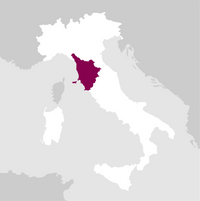Description
Pleasant and recognisable by its extreme elegance, Occhione is the estate's only white wine. As rare as the bird species that nests in the dunes and sands of Marina di Bibbona, it is a wine full of Mediterranean charm, possessing finesse and lightness but with an equally deep and persistent mouthfeel. Made in small quantities, it displays a certain stylistic and sensory a nity with the area's memorable red wines, thanks to its moderate concentration and richness.
Details

Perfume

Color

Taste
Serve at:
10 - 12 °C.
Longevity:
03 - 05 years

Pairings
- Hectares: 56
The terroir is predominantly sandy, and the microclimate is influenced by proximi- ty to the Tyrrhenian Sea: at Campo di Sasso, sea breezes blow constantly, reducing humidity and softening the hot summer temperatures in the vineyard, resulting in perfect grape ripening. In addition to Syrah—a historic variety for Campo di Sasso—Merlot, Sangiovese, and Petit Verdot are grown for red wines, and Vermentino for white wines.
The wines of Campo di Sasso express the territory with elegance and immediacy. Read more


| Name | Campo di Sasso Occhione 2024 |
|---|---|
| Type | White green still |
| Denomination | Toscana IGT |
| Vintage | 2024 |
| Size | 0,75 l |
| Alcohol content | 13.0% by volume |
| Grape varieties | 100% Vermentino |
| Country | Italy |
| Region | Tuscany |
| Vendor | Tenuta Campo di Sasso (Biserno) |
| Soil composition | Medium consistency soils with a combination of sand and pebbles. |
| Cultivation system | Spurred cordon and Guyot. |
| Plants per hectare | 6500 |
| Harvest | The Vermentino harvest began in the first week of September. It took place in the early hours of the morning, when temperatures were cooler, strictly by hand in order to make an initial selection of the grapes directly in the vineyard. |
| Wine making | The freshly picked grapes are transported to the cold store and brought to a temperature of 8 0°C. After selection on a sorting belt, the grapes undergo soft pressing to obtain the free-run juice. The must ferments in temperature-controlled steel tanks. The temperature is gradually increased to a maximum of 16°C towards the end of the process to preserve the freshness of the aromas. |
| Aging | Thirty days of ageing on fine lees with daily bâtonnage precede the composition of the final blend, which matures for a further two months. |
| Total acidity | 5.6 gr/L |
| PH | 3.15 |
| Allergens | Contains sulphites |




